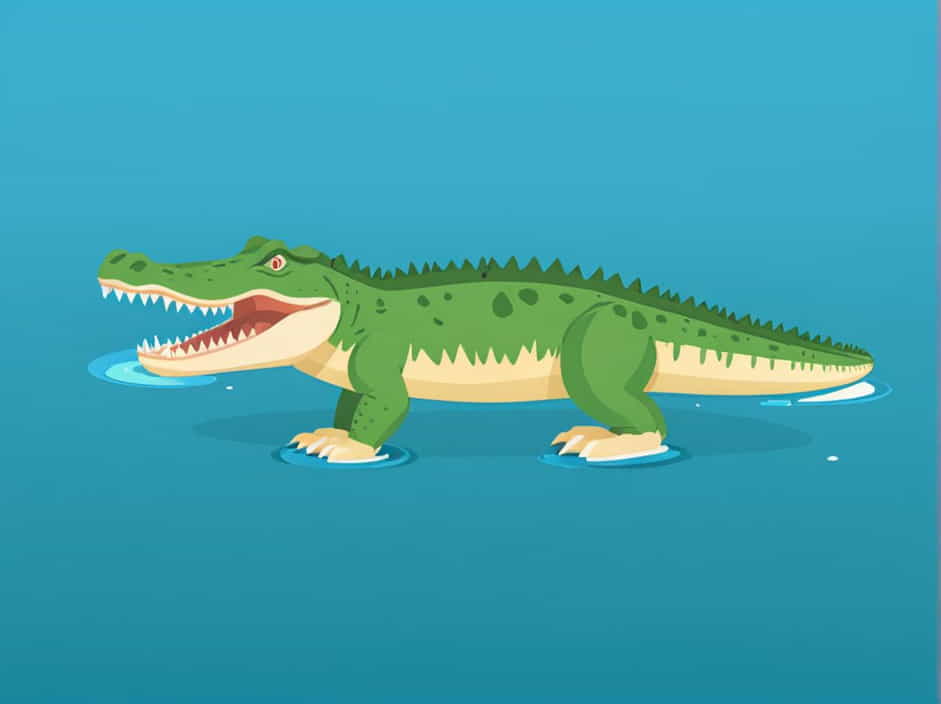The Nile crocodile (Crocodylus niloticus) and the saltwater crocodile (Crocodylus porosus) are two of the largest and most powerful crocodilian species in the world. Both are top predators in their respective habitats and share many similarities, yet they also have key differences in size, behavior, habitat, and hunting techniques.
This topic will provide an in-depth comparison between the Nile crocodile and the saltwater crocodile, helping to understand what makes each of them unique.
1. Habitat and Distribution
Nile Crocodile Habitat
The Nile crocodile is primarily found in freshwater rivers, lakes, and swamps across Africa. Its range extends from Egypt to South Africa, covering regions such as:
- The Nile River
- The Zambezi River
- The Okavango Delta
These crocodiles prefer warm freshwater environments, although some have been spotted in brackish waters.
Saltwater Crocodile Habitat
The saltwater crocodile, also known as the “salty”, has a much larger range. It is found in coastal regions, rivers, and estuaries across Southeast Asia, Northern Australia, and India. Key locations include:
- Northern Australia
- Indonesia and the Philippines
- The Bay of Bengal
Unlike Nile crocodiles, saltwater crocodiles are highly tolerant to saltwater and can travel across open seas, sometimes venturing to islands hundreds of miles away.
2. Size and Physical Differences
Which One Is Bigger?
The saltwater crocodile is the largest living reptile in the world, often surpassing the Nile crocodile in size.
| Feature | Nile Crocodile | Saltwater Crocodile |
|---|---|---|
| Average Length | 10-16 feet (3-5 meters) | 14-23 feet (4-7 meters) |
| Maximum Length | 18 feet (5.5 meters) | 23 feet (7 meters) |
| Weight | 500-1,650 lbs (225-750 kg) | 1,000-2,200 lbs (450-1,000 kg) |
Saltwater crocodiles not only grow larger but also tend to have wider skulls, thicker bodies, and more robust tails compared to Nile crocodiles.
3. Behavior and Aggression
Are Nile Crocodiles More Aggressive?
Both species are extremely dangerous, but Nile crocodiles are known to be more aggressive towards humans. They live in densely populated areas, increasing human encounters. Hundreds of attacks are reported yearly, making them one of the most dangerous reptiles in Africa.
Saltwater Crocodile Behavior
Saltwater crocodiles are territorial and highly aggressive, but they usually stay away from humans unless provoked. However, when they do attack, they are stronger and deadlier due to their larger size and power.
Both crocodiles ambush their prey with incredible stealth, patience, and power.
4. Hunting and Diet
Both species are apex predators, meaning they have no natural enemies in their environment.
Nile Crocodile Diet
Nile crocodiles are opportunistic hunters that eat:
- Fish, antelopes, and zebras
- Birds and smaller crocodiles
- Occasionally humans
They hunt in groups, sometimes working together to trap larger prey.
Saltwater Crocodile Diet
Saltwater crocodiles consume:
- Large mammals like water buffalo, boars, and sharks
- Seabirds and sea turtles
- Humans (rare but possible)
Unlike Nile crocodiles, saltwater crocodiles often hunt alone and use explosive power to drag their prey into the water.
5. Bite Force: Which One Is Stronger?
Both crocodiles have extremely powerful bites, but the saltwater crocodile has the strongest bite force of any animal.
- Nile crocodile bite force: 3,000-5,000 psi (pounds per square inch)
- Saltwater crocodile bite force: 3,700-5,500 psi
To put this into perspective, a lion’s bite force is only around 650 psi, meaning these crocodiles can crush bones instantly.
6. Speed on Land and in Water
Both crocodiles are surprisingly fast in the water but slow on land.
| Speed | Nile Crocodile | Saltwater Crocodile |
|---|---|---|
| Water Speed | 20-25 mph (32-40 km/h) | 15-18 mph (24-29 km/h) |
| Land Speed | 7-10 mph (11-16 km/h) | 7-9 mph (11-14 km/h) |
Nile crocodiles tend to be faster in the water, while both species have similar speeds on land.
7. Reproduction and Lifespan
Nesting and Reproduction
- Nile crocodiles lay 25-80 eggs per clutch and guard their nests aggressively.
- Saltwater crocodiles lay 40-60 eggs, with females being very protective.
Both species have a high mortality rate for hatchlings, with most being eaten by predators before reaching adulthood.
Lifespan
- Nile crocodiles live 50-70 years in the wild.
- Saltwater crocodiles can live over 70 years, with some reaching 100 years in captivity.
8. Which One Is More Dangerous to Humans?
Both crocodiles are responsible for fatal attacks, but the Nile crocodile is considered more dangerous.
| Feature | Nile Crocodile | Saltwater Crocodile |
|---|---|---|
| Annual Human Attacks | 200-500 | 20-30 |
| Fatality Rate | Very high | High |
Nile crocodiles live in densely populated regions, leading to more attacks compared to saltwater crocodiles, which are mostly found in remote coastal areas.
Which Is the Ultimate Predator?
Both the Nile crocodile and the saltwater crocodile are among the world’s most powerful reptiles, but they have key differences:
- The saltwater crocodile is larger, stronger, and has the most powerful bite force.
- The Nile crocodile is more aggressive and responsible for more human attacks.
- Both are apex predators in their habitats and nearly unstoppable in the wild.
In a fight, the saltwater crocodile would likely win due to its larger size and stronger bite, but the Nile crocodile’s aggression and numbers make it equally formidable in Africa.
